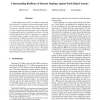Free Online Productivity Tools
i2Speak
i2Symbol
i2OCR
iTex2Img
iWeb2Print
iWeb2Shot
i2Type
iPdf2Split
iPdf2Merge
i2Bopomofo
i2Arabic
i2Style
i2Image
i2PDF
iLatex2Rtf
Sci2ools
DSN
2007
IEEE
2007
IEEE
Understanding Resiliency of Internet Topology against Prefix Hijack Attacks
A prefix hijack attack involves an attacker announcing victim networks' IP prefixes into the global routing system. As a result, data traffic from portions of the Internet can be diverted to attacker networks. Prefix hijack attacks are a serious security threat in the Internet and it is important to understand the factors that affect the resiliency of victim networks against these attacks. In this paper, we conducted a systematic study to gauge the effectiveness of prefix hijacks launched at different locations in the Internet topology. Our study shows that direct customers of multiple tier1 networks are the most resilient, even more than the tier1 networks themselves. Conversely, if these customer networks are used to launch prefix hijacks, they would also be the most effective launching pads for attacks. We verified our results through case studies using real prefix hijack incidents that had occurred in the Internet.
| Added | 14 Aug 2010 |
| Updated | 14 Aug 2010 |
| Type | Conference |
| Year | 2007 |
| Where | DSN |
| Authors | Mohit Lad, Ricardo V. Oliveira, Beichuan Zhang, Lixia Zhang |
Comments (0)

